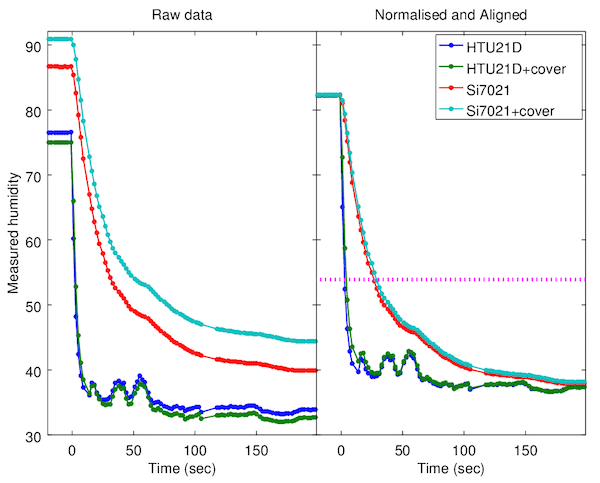Response speed of HTU21D and Si7021
Introduction
In most respects the specifications and interfaces of these two devices are virtually the same. The big difference is response speed where the Measurement Specialties device claims 5sec and Silicon Labs offers 17sec. Results in my large group test confirmed that the HTU21D was indeed one of the fastest available and the Si7021 the slowest by a large margin. This test looks at that difference in more detail.
A second matter of interest is to what extent the optional protective PTFE cover over the sensor affects response speed. My selection of devices includes two Si7021 with covers and two HTU21D without covers. I moved a cover from a Si7021 onto one of the HTU21D so that I have one of each, both with and without covers. Note however that my HTU21D is using the membrane from an Si7021, not the actual membrane that would be provided as stock from Measurement Specialties.
| Manufacturers' Specification | ||
| HTU21D | Si7021 | |
| Operating Range | 0–100 | 0–100 |
| Absolute accuracy (%RH, 25°C) | ±3% (20-80%) ±5% (<20, >80%) |
±3% (0-80%) ±5% (>80%) |
| Repeatability (%) | - | ±0.025 |
| Long term stability (% per year) |
0.5 | 0.25 |
| 1/e Response (sec) | 5 | 18 (with cover) 17 (without) |
| Voltage supply (V) | 1.5–3.6 | 1.9–3.6 |
My method for this test was to allow the devices to stabilise in one of my saturated solution test jars, then remove it quickly and monitor the reponse as the device is exposed to the uncontrolled open atmosphere. The upwards step reponse was investigated by going from NaOH (RH∼7%) to ambient and the downwards step was KCl (RH∼84%) to ambient.
Results
The figures below show the results. In each case the raw data are in the left panel and for the right panel the values have been scaled and aligned for easier comparison. For both upwards and downwards step the HTU21D reaches 63% of the change value in 3sec compared to the 5sec specification. The Si7021 is a lot slower than the 17sec specification at around 30sec. I am not sure why my results are so much slower than the datasheet suggests. The datasheet does specify a 1m/s air stream and though I had a fan running it was not calibrated to deliver any particular flow rate.


I suspect this is a deliberate design choice and the Si7021 may even be using an internal digital smoothing filter to elliminate high frequency spikes and wobbles in the humidity. For most purposes, especially meteorology or atmospheric control such as air conditioning, this slow response is probably desirable. You do not want to see and respond to every tiny waft of humid air that drifts over the sensor and would most likely add a data smoothing function of your own anyway. Inspection of the curves above, especially the downwards curve in Figure 2 makes it clear that all those bumps and wiggles are real. They are detected in all four devices. Though the Si7021 has heavily smoothed over them, you can see small features that align with the spikes in the HTU21D.
In summary, the Si7021 is obviously much slower to respond than the HTU21D but I do not see that as problem. Depending on your application it might be an advantage. At far less than a minute it is amply fast enough to trace the variations expected in normal atmosphere. The speed of the HTU21D may be important if you are trying to do something specialised like monitoring rapid fluctuations in a forced air flow. Note also that the Bosch Sensortec BME280 includes a configurable smoothing filter so you can select high or low reponse rate depending on your requirements.
Influence of the Protective Cover
The PTFE cover membrane seems to have almost no effect on speed of response. The Si7021 datasheet says the device is 1sec slower with the cover in place. That is exactly what I see here. For both kinds of devices, in both upwards and downwards changes, the device with the cover lagged the device without by about 1sec.
It seems to me that if the cover provides any protection whatsoever from environmental contamination then it is well worth leaving it installed.
Go to the HTU21D, Si7021, BME280, AM23xx(DHT22) comparison test.
Back to the index of all my hygrometer testing.
2017-03-26 5:21 PM